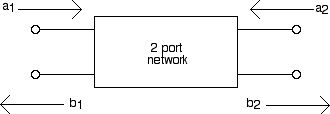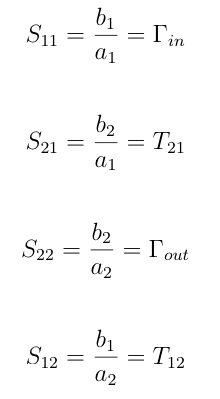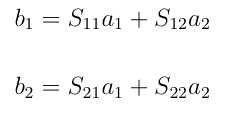SCATTERING PARAMETERS
Scattering parameters are useful as another means of characterizing networks. When the circuit demensions are small relative to the wavelength, the more usual Z, Y, or H parameters may be the descriptions of choice. The S parameters can be used in a similar manner when the lumped approximation is no longer valid. For the case of a two port network:

where the a's are incident waves and the b's are reflected waves. The wave quantities can be voltages or currents but the more common useage is in terms of voltages. A defining difference between two port scattering parameters and other representations, e.g., Z parameters, is that the port quantities of the others consist of total voltages and currents with no separation of incident and reflected. Indeed, the defining nature of the lumped element component is that it's a model valid only at a point in space where wave description loses relevance.
The scattering parameters are expressed in terms of the incident and reflected
waves as follows:

If port 1 quantities are measured with port 2 terminated in a matched load so
that a2 is zero, and port 2 quantities are measured with port 1 terminated in a
matched load so that a1 is zero, the following definitions apply:

where the gammas and the taus are reflection and transmission coefficients, respectively.
A major advantage in the use of scattering parameters at higher frequencies is
evident from these definitions. Virtually ideal characteristic impedance terminations
are readily available so that measurement accuracy is relatively high. This is
contrasted to the use of Z, Y, or H parameters where measurements require the use
of open or short circuit terminations. Ideal opens and shorts are generally not
achievable at the higher frequencies. Open circuits can generally exhibit resistive
components due to radiation and capacitive components due to fringing effects; short
circuits present implementation difficulties and may also have inductive effects.
These effects would compromise measurement accuracy. Another advantage is for the
measurement of active devices such as transistors which could be oscillatory for
reflective terminations.
Marcus Staloff
© 2013